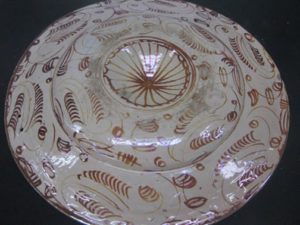Lustre technology was developed in the Middle East around the ninth century and flourished in the Islamic world. The tradition was maintained in Spain under Islamic and then Christian rule (from 1492) largely thanks to the continued presence of Muslim potters and the desirability of these wares through all of Europe.

It is a painterly technique involving the application of compounds of copper and silver, mixed with clay or ochre, to an already fired and glazed ceramic object. After the lustre has been applied, the vessel is then fired again at lower temperatures in another, smaller kiln. Firing in this special, oxygen-reduced kiln enables the metallic compounds to bond to the surface of the glaze. Recent scientific analysis has shown this metallic layer to be extremely thin, at 0,2 microns (or 0,0002 mm). The result is a metallic sheen resembling precious objects of gold and silver, which only reveals its full irridescence in optimum lighting conditions.
The colour and opacity of Spanish lustreware glazes depends on the quantity of tin used in their preparation. The more tin they contain, the whiter and more opaque the glaze. But tin was expensive, as it had to be imported from southwest England, and over time potters began to economise and make up glazes with less tin, resulting in clay-coloured tones, such as in this dish.
The colour of lustre depends on the exact combination of the metallic oxides, as well as the temperature in the kiln and other variables such as the interaction with the tin in the glaze. Lustre with a higher silver content creates a subtle golden sheen whereas lustre with a higher copper content is reddish brown. At the height of Valencian lustreware in the fifteenth century, hues tended to yellow or amber gold, changing to orange-gold, and eventually becoming browner and redder in the sixteenth and seventeenth centuries and beyond. Recent technical analyses of lustreware compositions have noted that later lustres (of the 17th and 18th centuries), although they appear redder, are not so because there is less silver but rather because there is more copper used. Previously it was thought that the red tones were due to potters’s economising in their use of silver. However this new discovery could change the conventional thinking about later wares, implying the motivation was a change in taste or fashion (with a preference for redder tones) rather than one of economics. Red tones are typical of the late period, as for example in this two handled vase.
Back to Spanish Lustre Dish


